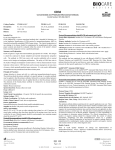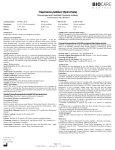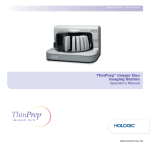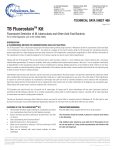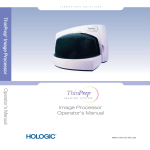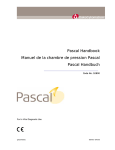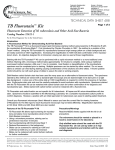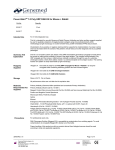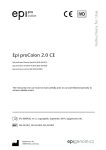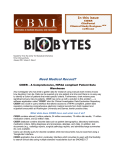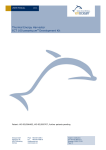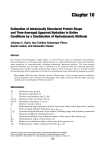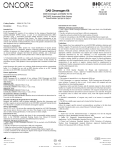Download standard operating procedure title - UK HealthCare
Transcript
University of Kentucky Markey Cancer Center Biospecimen Core Program BCP H.8 113A, Combs Building, 800 Rose Street.; Lexington, KY 40536; ph: (859) 257-4717; ph: (859) 323-2618; fax: (859) 257-3757 10/10/12 Page 1 of 6 IHC with Vecstain Kit _________________________________________________________________________________________________________ SUBJECT: IHC WITH VECTASTAIN KIT I. PRINCIPLE (Purpose): The ABC system is widely accepted as one of the most sensitive, economical and reliable immunoperoxidase systems available. The ABC system is based on the extraordinarily high affinity of the glycoprotein avidin for the small molecular weight vitamin, biotin. Because this affinity is over one million times higher than that of antibody for most antigens, the binding of avidin to biotin (unlike antibody-antigen interactions) is essentially irreversible. In addition to this high affinity, the Biotin/Avidin System can be effectively exploited because avidin has four binding sites for biotin and most proteins (including antibodies and enzymes) can be conjugated with several molecules of biotin. These aspects provide the potential for macromolecular complexes to be formed between avidin and biotinylated enzymes. An immunoperoxidase procedure based on these properties was devised for localizing a variety of histologically significant antigens and other markers. This technique employs unlabeled primary antibody, followed by biotinylated secondary antibody and then a pre-formed Avidin and Biotinylated horseradish peroxidase macromolecular Complex. This system requires more time than the standard DAKO Envision (+) system, which utilizes a polymer conjugated to secondary antibody and HRP, but it does allow researchers to use primary antibodies raised in hosts other than mouse or rabbit. Since many research grade antibodies are raised in goat or rat or various other species, the flexibility in choice of secondary antibody offsets the additional time required for staining. II. ROLE: A. Research Analyst V. SPECIMENS (Samples): (A). 10% neutral buffered formalin is the most common fixative. Tissues should be fixed for 6 to 12 hours. However, it should be understood that all fixation procedures result in some reduction of antigen recognition. Formalin fixation should be kept to a minimum, and the laboratory should test each primary antibody used in a fixation test protocol to verify that the fixation of the specimen is not creating negative specimens from positive ones. (B). The specimen will consist of formalin fixed paraffin embedded (FFPE) tissues, fixed smears, or cultured cells adhered to glass slides. (C). Specimens (FFPE tissues) should be cut into 3-4µm thickness (unless designated by a specific primary antibody) and mounted on positively charged slides. (D). Paraffin sections should be mounted from a preheated floatation bath containing distilled or deionized water (bath temperature per institution guidelines). The water bath should contain no additives such as gelatin, stay-on, polylysine, etc.. It is important to drain the water from beneath the section by standing the slide vertically on end. Dry in an oven at approx. 60 ºC for 30 to 60 minutes. (E). Slides containing smears must contain no large clumps of other accumulations of material that cause “lumpiness” of the smear surface. Any clumps of material will be too thick for adequate microscopic visualization. \\ukhcdata01\dept\Markey\Markey Administration\BCP\SOP\BCP-SOP\Histology SOP\Current Histology SOP\Immunohistochemistry\BCP H.8 IHC with Vectastain Kit.docx University of Kentucky Markey Cancer Center Biospecimen Core Program BCP H.8 113A, Combs Building, 800 Rose Street.; Lexington, KY 40536; ph: (859) 257-4717; ph: (859) 323-2618; fax: (859) 257-3757 10/10/12 Page 2 of 6 IHC with Vecstain Kit _________________________________________________________________________________________________________ (F). Smears or cultured cell preparations should be fixed prior to staining. Fixed, air-dried smears or cultures may be stained starting with the first aqueous buffer step of the protocol. VI. MATERIALS, REAGENTS, EQUIPMENT and SAFETY PRECAUTIONS: A. Equipment 1.Tissue Tek containers or coplin jars. 2. Forceps 3. Drying oven, capable of maintaining 60 °C or less 4. Wash bottle 5. Kim Wipes or absorbent wipes 6. Coverslips 7. Slides- SuperFrost Plus 8. Timer (capable of 3 – 40 minute intervals) 9. Humid chamber B. MATERIALS 1. RETRIEVAL BUFFER (e.g. 10X Citrate diluted to appropriate concentration) 2. TBST Buffer Solution a. For liquid concentrate: Mix 250 milliliters buffer with 2.25 Liters of distilled or deionized water. Stored at room temperature buffer is good for approximately 2 weeks. If buffer becomes cloudy discard immediately. 3. Proteinase K- Commercially purchased from DakoCytomation (S3004) or RTU (3020) with expiration date on the container. Store at 2 – 8 °C. 4. Hydrogen Peroxide- 0.03% hydrogen in methanol 5. Primary Antibody 6. Negative Control Serum (rabbit or mouse, as appropriate), store at 2 – 8 °C. Expiration date is on container. 7. Biotinylated secondary antibody targeted to appropriate specie (Varies based on host in which primary antibody was raised). 8. ABC from Vectastain kit 9. Hematoxylin 10. Substrate Chromogen: DAB+ (3-3’diaminobenzidine, mix one drop (20uL) Liquid DAB+ Chromogen to 1mL Buffered Substrate. Prepared Substrate-Chromogen solution is stable for approximately 5 days when stored at 2-8 °C. This solution should be mixed thoroughly prior to use. Any precipitate developing in the solution does not affect staining quality. 11. Xylene or Xylene Substitutes 12. Reagent Alcohol 13. Mounting Media VII. QUALITY CONTROL Positive Control Tissue Controls should be fresh surgical specimens, autopsy tissue or cell pellets- fixed, processed and embedded as soon as possible in the same manner as the experimental samples. Positive control tissues are indicative of correctly prepared tissue and proper staining techniques. One positive control tissue for each set of test conditions should be included in each staining run. If the positive control tissue fails to demonstrate positive staining, results with the test specimen should be considered invalid. \\ukhcdata01\dept\Markey\Markey Administration\BCP\SOP\BCP-SOP\Histology SOP\Current Histology SOP\Immunohistochemistry\BCP H.8 IHC with Vectastain Kit.docx University of Kentucky Markey Cancer Center Biospecimen Core Program BCP H.8 113A, Combs Building, 800 Rose Street.; Lexington, KY 40536; ph: (859) 257-4717; ph: (859) 323-2618; fax: (859) 257-3757 10/10/12 Page 3 of 6 IHC with Vecstain Kit _________________________________________________________________________________________________________ Negative Control Tissue Use a negative control reagent in place of the primary antibody with a section of each experimental specimen to evaluate nonspecific staining and allow better interpretation of specific staining at the antigen site. Refer to the product insert of each primary antibody for specific recommendations. The incubation period for the negative control reagent should be the same as the primary antibody. SAFETY PRECAUTIONS X. PROCEDURE 1. Cut sections to 3-4µm thickness. Place the sections on positively charged slides, or silanized slides. DO NOT use additives in the floatation bath. Heat slides in oven at 58 to 60 °C for 30 to 60 minutes. 2. Deparaffinization and Rehydration. Prior to staining, tissue slides must be deparaffinized to remove embedding medium and rehydrated. Avoid incomplete removal of paraffin. Residual embedding medium will result in non-specific staining. This step should be performed at room temperature (20 –25 °C). a) Place slides in a xylene or xylene substitute bath and incubate for 5 (± 1) minute. Change bath and repeat 1 to 2 times. b) Tap off excess liquid and place slides in 100% alcohol for 3 (± 1) minute. Change bath and repeat 1 to 2 times. c) Tap off excess liquid and place slides in 95% alcohol for 3 (± 1) minute. Change bath and repeat 1 to 2 times. d) Tap off excess liquid and place slides in distilled or deionized water for a minimum of 30 seconds. Note: Xylene and alcohol solutions should be changed after 40 slides. 3. If necessary perform antigen retrieval techniques and/or enzyme digestion step a) Place the enzyme digestion reagent on the tissue for designated time (Proteinase K generally 5 min.) OR a) Place slides in a plastic container with Target Retrieval Solution and heat in Decloaking chamber. See BCP H.6 Steam Retrieval. b) Remove the plastic container from the chamber and let stand at room temperature for at least 20 minutes. c) Place slides in Tris Buffer with Tween for 5 minutes. 4. Peroxidase Block. Tap off excess buffer. Using a lintless tissue (such as a Kim wipe), carefully wipe around the specimen to remove any remaining liquid and to keep reagents within the prescribed area. Apply enough reagent to cover specimens. Incubate 5 (± 1) minutes. Rinse gently with distilled or deionized water or Wash Buffer from a wash bottle and place in a fresh bath of wash buffer. 5. Primary Antibody or Negative Control Reagent Tap off excess buffer. Using a lintless tissue (such as a Kim wipe), carefully wipe around the specimen to remove any remaining liquid and to keep reagents within the prescribed area. Apply enough Primary or Negative Control reagent to cover specimen (approximately 200µL). Incubate for appropriate time at indicated \\ukhcdata01\dept\Markey\Markey Administration\BCP\SOP\BCP-SOP\Histology SOP\Current Histology SOP\Immunohistochemistry\BCP H.8 IHC with Vectastain Kit.docx University of Kentucky Markey Cancer Center Biospecimen Core Program BCP H.8 113A, Combs Building, 800 Rose Street.; Lexington, KY 40536; ph: (859) 257-4717; ph: (859) 323-2618; fax: (859) 257-3757 10/10/12 Page 4 of 6 IHC with Vecstain Kit _________________________________________________________________________________________________________ temperature. For most antibodies, this is 30 minutes to 1 hour at room temperature, though other primary antibodies have enhanced staining when incubated overnight at 4°C. Refer to the SOP for the particular antibody being used. Rinse gently with wash buffer from a wash bottle (do not focus flow directly on tissue) and place slides in a fresh wash buffer bath. 6. Secondary antibody Tap off excess buffer. Using a lintless tissue (such as a Kim wipe), carefully wipe around the specimen to remove any remaining liquid and to keep reagents within the prescribed area. Apply enough biotinylated secondary antibody, appropriately diluted in TBST or dilution buffer, to cover specimen (approximately 200µL). At this time the ABC should be prepared (see next step). Incubate 30 (± 1) minute. Rinse gently with wash buffer from a wash bottle (do not focus flow directly on tissue) and place slides in a fresh wash buffer bath. 7. ABC Avidin and biotin require at least 30 minutes at room temperature to complex. Be sure to prepare the mixture by the time secondary antibody is applied to slides. Add exactly two (2) drops of REAGENT A to 5 ml of buffer, mix well then add exactly two (2) drops of REAGENT B to the same bottle, mix immediately, and allow to stand for about 30 minutes before use. Apply enough to cover tissue and incubate at room temperature for 30 minutes. Rinse gently with wash buffer from a wash bottle (do not focus flow directly on tissue) and place slides in a fresh wash buffer bath. 8. Substrate-Chromogen Solution (DAB+) Tap off excess buffer. Using a lintless tissue (such as a Kim wipe), carefully wipe around the specimen to remove any remaining liquid and to keep reagents within the prescribed area. Using a pipette apply enough Substrate –Chromogen solution to cover specimen (approximately 200µL). Incubate for 5 - 10 minutes or until adequate signal develops. Rinse gently with distilled or deionized water only (do not focus flow directly on tissue). Collect substrate-chromogen solution waste in a hazardous materials container for proper disposal. 9. Counterstain (Directions are for HEMATOXYLIN). Immerse slides in a bath of hematoxylin. Incubate for 2-5 minutes, depending on the strength of hematoxylin used. Rinse slides in a bath of distilled or deionized water for 2-5 minutes. Ensure all residual hematoxylin has been cleared. Dip slides 10 times into a bath of 37mmol/L ammonia water. Rinse slides in a bath of distilled or deionized water for 2-5 minutes. Note: Depending on the incubation length and potency of the hematoxylin used counterstaining will result in a pale to dark to dark blue coloration of the cell nuclei. Excessive or incomplete counterstaining may compromise proper interpretation of results. 10. Dehydration and clearing of slides After staining, if slides are to be mounted with a non-aqueous, permanent mounting media you must remove all water before coverslipping. This step should be performed at room temperature (20-25 °C). a) Place slides in 95% alcohol and incubate for 5 (± 1) minute. Change bath and repeat once. b) Tap off excess liquid and place slides in 100% alcohol for 3 (± 1) minute. Change bath and repeat once. c) Tap off excess liquid and place slides in xylene or xylene substitute for 3 (± 1) minute. Change bath and repeat 1 to 2 times. 11. Mounting \\ukhcdata01\dept\Markey\Markey Administration\BCP\SOP\BCP-SOP\Histology SOP\Current Histology SOP\Immunohistochemistry\BCP H.8 IHC with Vectastain Kit.docx University of Kentucky Markey Cancer Center Biospecimen Core Program BCP H.8 113A, Combs Building, 800 Rose Street.; Lexington, KY 40536; ph: (859) 257-4717; ph: (859) 323-2618; fax: (859) 257-3757 10/10/12 Page 5 of 6 IHC with Vecstain Kit _________________________________________________________________________________________________________ Non-aqueous, permanent mounting media are recommended when using DAB+ as the substrate chromogen. Otherwise, aqueous mounting media are also acceptable. NOTE: Slides may be read when convenient. However some fading may occur if slides are coverslipped with an aqueous mounting medium and exposed to strong light over a period of one week. To minimize fading, store slides in the dark at room temperature (20-25 °C). XIII. REFERENCES: Vector Laboratories Vectastain Universal Elite ABC Kit User Manual. http://vectorlabs.com/data/protocols/PK6200.pdf XV. HISTORY BLOCK Replaces: Changes: NEW XVI. APPROVAL BLOCK: Written by: Dana Napier Date: 10/10/2012 Revised by: Date: Approved by:_____________________ Scientific Director Date: ____________________ Approved by:_____________________ Date: ____________________ Medical Director Annual Review Signed By: Name in Print Date: Signature Name in Print Date: Signature Name in Print Date: Signature \\ukhcdata01\dept\Markey\Markey Administration\BCP\SOP\BCP-SOP\Histology SOP\Current Histology SOP\Immunohistochemistry\BCP H.8 IHC with Vectastain Kit.docx University of Kentucky Markey Cancer Center Biospecimen Core Program BCP H.8 113A, Combs Building, 800 Rose Street.; Lexington, KY 40536; ph: (859) 257-4717; ph: (859) 323-2618; fax: (859) 257-3757 10/10/12 Page 6 of 6 IHC with Vecstain Kit _________________________________________________________________________________________________________ Signature Name in Print Date: Signature Name in Print Date: Signature Name in Print Date: Signature Name in Print Date: Signature Name in Print Date: Signature Name in Print Date: Signature Name in Print Date: Date this version is removed from the manual: Date the procedure is retired: \\ukhcdata01\dept\Markey\Markey Administration\BCP\SOP\BCP-SOP\Histology SOP\Current Histology SOP\Immunohistochemistry\BCP H.8 IHC with Vectastain Kit.docx






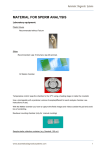
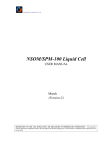
![Progesterone Receptor (PR) [16]](http://vs1.manualzilla.com/store/data/005703733_1-5d4a6a4c070c4aacc906912b3410a27a-150x150.png)
